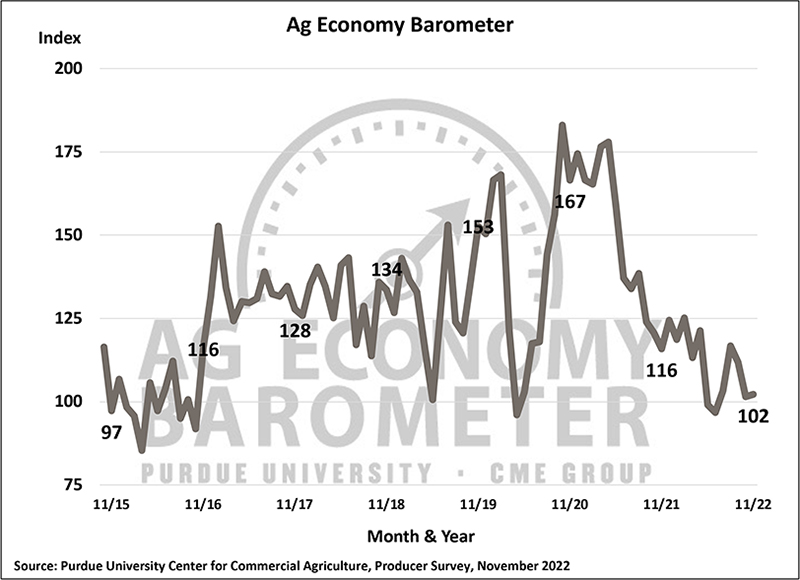High input costs and rising interest rates top concerns as farmer sentiment remains unchanged
Unlike the two most recent presidential elections, the November mid-term election outcomes did little to swing farmer sentiment. The Purdue University/CME Group Ag Economy Barometer came in at a reading of 102 in November, unchanged from October. There was however a slight movement in both of the barometer’s sub-indices. The Current Conditions Index declined 3 points to a reading of 98, while the Future Expectations Index increased 2 points to a reading of 104. The Ag Economy Barometer is calculated each month from 400 U.S. agricultural producers’ responses to a telephone survey. This month’s survey was conducted after the U.S. mid-term elections Nov. 14-18.
“Even though sentiment remained relatively unchanged in November, producers are continuing to look at their bottom line,” said James Mintert, the barometer’s principal investigator and director of Purdue University’s Center for Commercial Agriculture. “Rising interest rates combined with high input and energy costs are creating a lot of uncertainty at the farm level.”
The Farm Financial Performance Index improved modestly this month to 91, up 5 points from October, but it remains 14% below this same time period last year. While nearly one-third of producers continue to express concern that their farm’s financial performance this year will be worse than the prior year, just over two-thirds of producers expect their farm’s 2022 financial performance to be equal to or exceed 2021’s. Still, high input costs continue to weigh on producers’ minds with 42% of respondents in this month’s survey citing that as their top concern in the year ahead. Just over one-fifth (21%) of respondents chose rising interest rates, while 14% cited input availability and declining commodity prices as a top concern.
The Farm Capital Investment Index dropped back to its record low of 31 in November, erasing gains from the previous month. Nearly 80% of respondents indicated now is a “bad time” to make large investments in farm machinery, and of those, 47% chose “rising prices of farm machinery and new construction” as the primary reason. By comparison, only 10% of respondents felt now is a “good time” to make large investments.
Given the sharp rise in energy prices that’s taken place this year, this month’s survey asked producers how they’ve responded to the cost increase. Just over one-fourth (27%) of this month’s respondents indicated they’ve made changes in their operation because of rising prices for energy. Of those who indicated they made changes, 33% indicated they reduced tillage, 24% reduced nitrogen rates and/or changed application timing, 11% increased their use of no-till, and 8% said they reduced crop drying.
Farmland auction results in the Corn Belt continue to set new record highs, yet producers show signs of becoming less bullish on farmland values. The Short-Term Farmland Value Expectation Index declined 4 points to a reading of 129, and the Long-Term Farmland Value Expectation Index remained unchanged at 144. Both indices are well below the highs established in fall 2021. When asked to look ahead one year, 12% of respondents this month said they expect values to decline compared to just 4% who felt that way a year ago. Among producers who expect farmland values to rise over the next 5 years, over half (52%) chose nonfarm investor demand as the primary reason for their optimism
Read the full Ag Economy Barometer report. The site also offers additional resources – such as past reports, charts and survey methodology – and a form to sign up for monthly barometer email updates and webinars.
Each month, the Purdue Center for Commercial Agriculture provides a short video analysis of the barometer results. For even more information, check out the Purdue Commercial AgCast podcast. It includes a detailed breakdown of each month’s barometer, in addition to a discussion of recent agricultural news that affects farmers.
The Ag Economy Barometer, Index of Current Conditions and Index of Future Expectations are available on the Bloomberg Terminal under the following ticker symbols: AGECBARO, AGECCURC and AGECFTEX.
About the Purdue University Center for Commercial Agriculture
The Center for Commercial Agriculture was founded in 2011 to provide professional development and educational programs for farmers. Housed within Purdue University’s Department of Agricultural Economics, the center’s faculty and staff develop and execute research and educational programs that address the different needs of managing in today’s business environment.
About CME Group
As the world’s leading and most diverse derivatives marketplace, CME Group (www.cmegroup.com) enables clients to trade futures, options, cash and OTC markets, optimize portfolios, and analyze data – empowering market participants worldwide to efficiently manage risk and capture opportunities. CME Group exchanges offer the widest range of global benchmark products across all major asset classes based on interest rates, equity indexes, foreign exchange, energy, agricultural products and metals. The company offers futures and options on futures trading through the CME Globex® platform, fixed income trading via BrokerTec and foreign exchange trading on the EBS platform. In addition, it operates one of the world’s leading central counterparty clearing providers, CME Clearing.
CME Group, the Globe logo, CME, Chicago Mercantile Exchange, Globex, and, E-mini are trademarks of Chicago Mercantile Exchange Inc. CBOT and Chicago Board of Trade are trademarks of Board of Trade of the City of Chicago, Inc. NYMEX, New York Mercantile Exchange and ClearPort are trademarks of New York Mercantile Exchange, Inc. COMEX is a trademark of Commodity Exchange, Inc. BrokerTec and EBS are trademarks of BrokerTec Europe LTD and EBS Group LTD, respectively. Dow Jones, Dow Jones Industrial Average, S&P 500 and S&P are service and/or trademarks of Dow Jones Trademark Holdings LLC, Standard & Poor's Financial Services LLC and S&P/Dow Jones Indices LLC, as the case may be, and have been licensed for use by Chicago Mercantile Exchange Inc. All other trademarks are the property of their respective owners.






